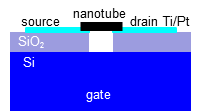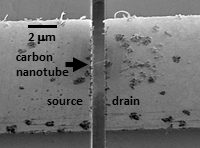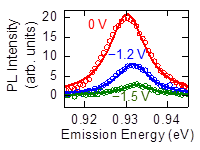Research:Gate-induced blueshift and quenching of photoluminescence in carbon nanotubes
Single-walled carbon nanotubes (SWCNTs) are very sensitive to environmental effects, and their optical properties are significantly affected by the dielectric constant of the environment. This is because bandgap and exciton binding energies are determined by the Coulomb interaction, and the strength of this interaction can vary significantly by dielectric screening.
When nanotubes are doped by electrostatic gating, the induced carriers are also expected to cause screening, and therefore modulate the emission energy. Investigation of electric field effects on optical properties is important for applications in nano-scale optoelectronics.


In order to apply electric fields while simultaneously monitoring photoluminescence (PL), we fabricate field effect transistors with suspended nanotubes. Since PL is quenched for nanotubes touching the substrate, we need to suspend them over trenches. We form the trenches and the contacts first, then grow carbon nanotubes by chemical vapor deposition. By applying a voltage to the Si substrate which acts as a back-gate, we can control the carrier density in the nanotube. We look for a device with an individual nanotube, and measure photoluminescence as a function of the gate voltage.
In the figure below, gate voltage dependence of PL is shown. Application of electric field causes PL quenching. In addition, the PL emission energy increases with gate voltage.

If doping induces screening, one would expect the energy to shift towards lower energy, however, doping also causes band filling, and that may be the reason for the blueshift. We also find that the quenching is stronger than theoretical models proposed so far, and allows modulation of PL intensity at low voltages.
To learn more about this work, please refer to:
Gate-induced blueshift and quenching of photoluminescence in suspended single-walled carbon nanotubes
Phys. Rev. B
84, 121409(R) (2011).
![]()